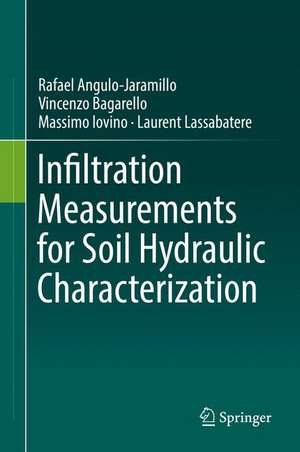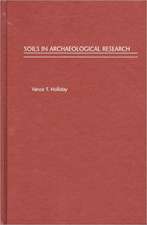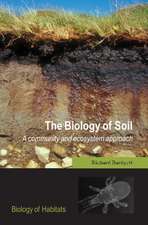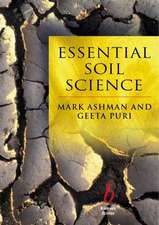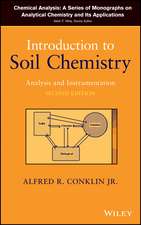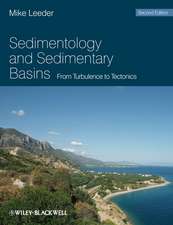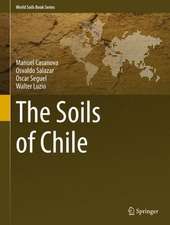Infiltration Measurements for Soil Hydraulic Characterization
Autor Rafael Angulo-Jaramillo, Vincenzo Bagarello, Massimo Iovino, Laurent Lassabatereen Limba Engleză Hardback – 8 iul 2016
| Toate formatele și edițiile | Preț | Express |
|---|---|---|
| Paperback (1) | 943.29 lei 38-44 zile | |
| Springer International Publishing – 30 mai 2018 | 943.29 lei 38-44 zile | |
| Hardback (1) | 1124.92 lei 3-5 săpt. | |
| Springer International Publishing – 8 iul 2016 | 1124.92 lei 3-5 săpt. |
Preț: 1124.92 lei
Preț vechi: 1371.86 lei
-18% Nou
Puncte Express: 1687
Preț estimativ în valută:
215.27€ • 223.39$ • 179.94£
215.27€ • 223.39$ • 179.94£
Carte disponibilă
Livrare economică 22 februarie-08 martie
Preluare comenzi: 021 569.72.76
Specificații
ISBN-13: 9783319317861
ISBN-10: 3319317865
Pagini: 413
Ilustrații: XI, 386 p. 136 illus., 22 illus. in color.
Dimensiuni: 155 x 235 x 25 mm
Greutate: 0.91 kg
Ediția:1st ed. 2016
Editura: Springer International Publishing
Colecția Springer
Locul publicării:Cham, Switzerland
ISBN-10: 3319317865
Pagini: 413
Ilustrații: XI, 386 p. 136 illus., 22 illus. in color.
Dimensiuni: 155 x 235 x 25 mm
Greutate: 0.91 kg
Ediția:1st ed. 2016
Editura: Springer International Publishing
Colecția Springer
Locul publicării:Cham, Switzerland
Cuprins
Foreword.- 1AN INTRODUCTION TO SOIL AND WATER INFILTRATION.- 1.1 Generalcharacteristics of soil.-1.2 Soil water content and potential.- 1.3 Flow ofwater in soils.- 1.4 Infiltration process and equations.- 1.4.1 Gravity freewater absorption.- 1.4.2 Green and Ampt model for infiltration.- 1.4.3 Philipinfiltration equation for capillary and gravity driven infiltration.- 1.4.4Sorptivity and flux concentration function
1.4.5 General infiltration solution of Parlange.- 1.4.6 Extension to 3D waterinfiltration below a disc source.- References.- 2 SATURATED SOIL HYDRAULIC CONDUCTIVITY.- 2.1 Well or boreholepermeameters.- 2.1.1 Steady flow under constant head in uncased boreholes.- 2.1.2Steady flow under constant head in cased boreholes.- 2.1.3 Transient flow underconstant head in cased and uncased boreholes.- 2.1.4 Falling-head flow in casedboreholes.- 2.2 Ring infiltrometers.- 2.2.1 Single-ring pressure infiltrometer.-2.2.2 Other single-ring approaches.- 2.2.3 Double-ring infiltrometer.- 2.2.4Simplified falling head technique.- 2.3 Dripper or point-source method.- References.-3 UNSATURATED SOIL HYDRAULIC PROPERTIES.-3.1 Tension or disk infiltrometer.- 3.1.1 Basis of the technique.- 3.1.2Apparatus and procedures.- 3.1.3 Analysis of steady-state flow.- 3.1.4 Analysisof transient flow.- 3.1.5 Numerical inversion of tension disk infiltrometerdata.- 3.1.6 Particular devices.- 3.1.7 Hydraulic contact at the infiltrationsurface.- 3.1.8 Applying the tension infiltrometer on sloping land.- 3.2 BEST -Beerkan estimation of soil transfer parameters procedure.- 3.2.1 Soil hydrauliccharacteristic curves
3.2.2 Soil particle-size distribution, bulk density and water content.- 3.2.3Water infiltration experiments.- 3.2.4 Estimating shape parameters by invertingparticle-size distribution data.- 3.2.5 Estimating scale parameters byinverting water infiltration data.- 3.2.6 Issues on estimation of shapeparameters.- 3.2.7 Issues on estimationof scale parameters.- 3.2.8 Tests ofthe soil hydraulic characteristic curves.- 3.2.9 Using the soil hydraulicparameters obtained with BEST.- References.- 4 SOILS WITH SPECIFIC FEATURES.- 4.1 Water repellent soils.- 4.1.1Causes of hydrophobicity.- 4.1.2 Hydrophobicity and water infiltration.- 4.1.3Hydraulic characterization of water repellent soils.- 4.2 Crusted soils.- 4.2.1Crust formation.- 4.2.2 Water infiltration experiments for crustcharacterization.- 4.3 Low permeability soils.- 4.3.1 Early-time constant-head(ECH) technique.- 4.3.2 Early-time falling-head (EFH) technique.- 4.3.3Sequential early-time constant-head/falling-head (ECFH) technique.- 4.3.4Saturated conductivity of low permeability wet soils.- 4.3.5 Time domains forpressure infiltrometer data.- 4.3.6 Accounting for soil swelling.- 4.4.Macroporous and bi-modal soils.- 4.4.1. Conceptual models for preferential flow.-4.4.2. Modelling water infiltration into dual permeability soils.- 4.4.3. Howto detect preferential flow.- 4.4.4. How to characterize dual permeabilitysoils.- References.- APPENDIX -ADDITIONAL MEASUREMENTS.- A1. Soil bulk density
A2. Soil water content.- A3. Soil water matric potential.- A4. Soil waterretention curve.- A5. Water stability of soil aggregates.- References.
1.4.5 General infiltration solution of Parlange.- 1.4.6 Extension to 3D waterinfiltration below a disc source.- References.- 2 SATURATED SOIL HYDRAULIC CONDUCTIVITY.- 2.1 Well or boreholepermeameters.- 2.1.1 Steady flow under constant head in uncased boreholes.- 2.1.2Steady flow under constant head in cased boreholes.- 2.1.3 Transient flow underconstant head in cased and uncased boreholes.- 2.1.4 Falling-head flow in casedboreholes.- 2.2 Ring infiltrometers.- 2.2.1 Single-ring pressure infiltrometer.-2.2.2 Other single-ring approaches.- 2.2.3 Double-ring infiltrometer.- 2.2.4Simplified falling head technique.- 2.3 Dripper or point-source method.- References.-3 UNSATURATED SOIL HYDRAULIC PROPERTIES.-3.1 Tension or disk infiltrometer.- 3.1.1 Basis of the technique.- 3.1.2Apparatus and procedures.- 3.1.3 Analysis of steady-state flow.- 3.1.4 Analysisof transient flow.- 3.1.5 Numerical inversion of tension disk infiltrometerdata.- 3.1.6 Particular devices.- 3.1.7 Hydraulic contact at the infiltrationsurface.- 3.1.8 Applying the tension infiltrometer on sloping land.- 3.2 BEST -Beerkan estimation of soil transfer parameters procedure.- 3.2.1 Soil hydrauliccharacteristic curves
3.2.2 Soil particle-size distribution, bulk density and water content.- 3.2.3Water infiltration experiments.- 3.2.4 Estimating shape parameters by invertingparticle-size distribution data.- 3.2.5 Estimating scale parameters byinverting water infiltration data.- 3.2.6 Issues on estimation of shapeparameters.- 3.2.7 Issues on estimationof scale parameters.- 3.2.8 Tests ofthe soil hydraulic characteristic curves.- 3.2.9 Using the soil hydraulicparameters obtained with BEST.- References.- 4 SOILS WITH SPECIFIC FEATURES.- 4.1 Water repellent soils.- 4.1.1Causes of hydrophobicity.- 4.1.2 Hydrophobicity and water infiltration.- 4.1.3Hydraulic characterization of water repellent soils.- 4.2 Crusted soils.- 4.2.1Crust formation.- 4.2.2 Water infiltration experiments for crustcharacterization.- 4.3 Low permeability soils.- 4.3.1 Early-time constant-head(ECH) technique.- 4.3.2 Early-time falling-head (EFH) technique.- 4.3.3Sequential early-time constant-head/falling-head (ECFH) technique.- 4.3.4Saturated conductivity of low permeability wet soils.- 4.3.5 Time domains forpressure infiltrometer data.- 4.3.6 Accounting for soil swelling.- 4.4.Macroporous and bi-modal soils.- 4.4.1. Conceptual models for preferential flow.-4.4.2. Modelling water infiltration into dual permeability soils.- 4.4.3. Howto detect preferential flow.- 4.4.4. How to characterize dual permeabilitysoils.- References.- APPENDIX -ADDITIONAL MEASUREMENTS.- A1. Soil bulk density
A2. Soil water content.- A3. Soil water matric potential.- A4. Soil waterretention curve.- A5. Water stability of soil aggregates.- References.
Textul de pe ultima copertă
This book summarises the main results of many contributions from researchers worldwide who have used the water infiltration process to characterize soil in the field. Determining soil hydrodynamic properties is essential to interpret and simulate the hydrological processes of economic and environmental interest. This book can be used as a guide to soil hydraulic characterization and in addition it gives a complete description of the treated techniques, including an outline of the most significant research results, with the main points that still needing development and improvement.
This work is aimed at Ph.D. students and researchers, with particular reference to the youngest ones. Examples are provided to offer a practical guide to technicians and practitioners.
“This book outlines the suite of infiltration measurement-techniques that can be used to characterize the soil’s hydraulic properties. This book is an essential companion for all soil scientists and environmental engineers.”
Brent Clothier, Plant & Food Research, Palmerston North, New Zealand.
Caracteristici
Numerous step-by-step tutorials for most infiltration experiments and hydraulic characterization methods Special chapter on ongoing research for soils exhibiting challenging properties (hydrophobic, crusted soils and dual permeable soils with macropores) Addresses both saturated and unsaturated hydraulic properties and their use for numerical modelling
